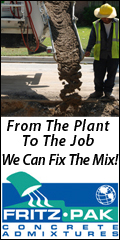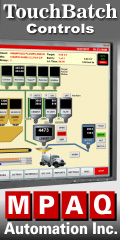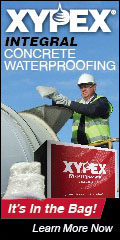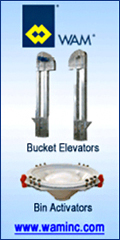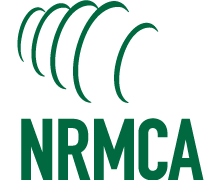
| Archive | nrmca.org | E-Store | Conferences & Events | Certifications | InFocus | Membership Directory |
NRMCA Attends ASTM Meeting in New Orleans, Provides Summary Report The following is a summary of activity at the ASTM meeting of Committees C09 on Concrete attended earlier this month by NRMCA staff in New Orleans.
C09.20 Concrete Aggregates - Revisions were approved to the methods to determine relative density (specific gravity) and absorption of aggregates, C127 and C128. The density of aggregate particles, calculated from the relative density was removed from the standards. Revisions were approved to C1777 – to determine the methylene blue index of fine aggregate samples - primarily clarification to procedures. A revision to ASTM C123 was approved to permit alternative less hazardous inorganic heavy liquids for determining lightweight particles in aggregates. The subcommittee is considering removing reference to the currently used organic liquids due to their hazardous nature. A specification for mineral fillers for use in concrete continues to progress through the ASTM balloting process. The balloted version received several negatives but the document is getting closer to being finalized. This specification will support the use of mineral fillers in concrete, which may be used in self-consolidating concrete or for other purposes. The subcommittee has balloted a definition of "recycled aggregate" in Specification ASTM C33 for concrete aggregates, with the intent to indicate that these materials can be used if they meet the requirements of C33. No changes to the existing requirements in C33 to accommodate the use of recycled aggregates are being proposed.
C09.24 Supplementary Cementitious Materials - The subcommittee has successfully balloted a change to ASTM C618 that would allow process additions in the boiler that facilitate fly ash manufacture. Process additions could include co-combustion of non-coal fuels such petcoke, biomass, etc., as well as non-organic additions such as lime, activated carbon, etc., all of which may impact concrete performance. A subcommittee ballot to eliminate the composition-based differentiation between Class C and Class F fly ashes failed. A ballot will be issued to establish differentiation between these classes of fly ash based on CaO limits, instead of the current sum of oxide limits.
C09.26 Chemical Reactions - Two sources of borosilicate glass for conducting the ASTM C441 test are available with the subcommittee chair and this information will be included in the meeting minutes. A ballot item will propose including the use of C595 blended cements in the concrete prism test, C1293. The precision and bias statements of C1260, C1567 and C1293 will be reevaluated to include guidance on range between the three expansion determinations that constitute a test as well as between test variations. A new dilatometer based ASR test that measures the ASR reactivity of the aggregates within a period of five days was evaluated and a task group formed to look at the feasibility of developing a standard. There was discussion to remove ASTM C227 and C289 from the standards due to their unreliability.
C09.40 Ready Mixed Concrete - Some significant revisions to ASTM C94 were approved, including:
• Clarifies that purchaser’s requirements stated in the order that differ from C94 govern and places a responsibility on the purchaser to communicate all requirements for concrete from a project specification.
• Air content requirements are set at two levels for moderate and severe exposure. The purchaser should either state the required air content or indicate the type of exposure so the producer can establish the required air content.
• Include a requirement that the purchaser should state the required density when ordering heavyweight concrete.
• Revisions to the appendix that advises on strength overdesign concepts.
• Separately states the time limitations for delivery to remove it from the section that deals with water addition at the job site or in transit.
Other revisions to C94 being considered include the use of electronic delivery tickets, stating the responsibility of the purchaser to ensure access and resources at the job site to obtain samples perform tests on concrete, and revisions to the section on batching concrete. The subcommittee will revisit the issue of eliminating time limits to delivery.
A new specification for reuse of returned concrete received several negatives but continues to make progress toward acceptance. C09.48 Performance of Cementitious Materials and Admixture Combinations - This subcommittee is working on several new standards that fit within its scope - to evaluate the adsorption characteristics of fly ash to iodine that can be used to evaluate its impact on air entrainment; standardize the foam index test for fly ash to evaluate the change in air entraining admixture dosage based on unburned carbon; a practice to evaluate the relative performance of various concrete materials and optimization using mortar mixtures; evaluating the early hydration of cementitious mixtures using thermal measurements; and estimation of the optimum sulfate content of hydraulic cement using isothermal calorimetry.
C09.50 Risk Management for Alkali Aggregate Reactions (AAR) - The subcommittee has finalized a new document "Determining Reactivity of Concrete Aggregates and Minimizing Risk of Deleterious Expansion" as ASTM C1778. The document is similar to the AASHTO provisional standard PP65. The subcommittee decided to work with various other subcommittees that currently refer to ASR tests such as ASTM C441. It was suggested that information referring to ASTM C1778 can be added as appropriate. ASTM C1778 tables provide guidance to ASR requirements based on anticipated service lives of structures. The service life is not based on specific modeling so there was discussion to reevaluate the tables that classify the structures. It was indicated that there was only one performance criterion for various conditions while there was multiple levels of prescriptive criteria.
C09.60 Fresh Concrete Tests - A revision to C172 on sampling to clarify the location of the sample from volumetric mixers was approved. Revisions were being considered to C173 (rollameter) regarding the alcohol correction to measured air and the precision statement. A comprehensive inter-laboratory study has been completed to develop a precision statement for the pressure air method, C231 and this will be proposed in a future ballot.
A presentation was delivered from BASF on the use of microspheres for freeze thaw durability of concrete; the quantity of microspheres was in the range of 1% by volume of concrete. By request of several users, a test method that verifies and measure the quantity of microspheres incorporated in fresh concrete will be proposed.
A request to reinstate ASTM C1362 (recently withdrawn) on the "K-slump tester" was rejected by the subcommittee. C09.61 Strength - A revision to ASTM C39 was approved regarding the calculation of compressive strength test result. The average strength should be calculated from the "unrounded" calculated strength value of each specimen. It was indicated that even though the difference was small, it could be of significance with core test results that are close to the acceptance criteria. Minor revisions are in progress for ASTM C39 for strength testing and to C617 for capping specimens with sulfur. The subcommittee was requested to include reporting requirements of C31 in the reporting section of C39 so that details of making and curing cylinders are included in the strength test reports.
C09.66 Fluid Penetration - The subcommittee continues to work on finalizing the surface resistivity test using Wenner probe which can be used for concrete quality assurance. The mass loss vs. time for one-dimensional drying of saturated concrete which can be used in service life prediction models was recently standardized as ASTM C1792-14. Changes to the ASTM C1760 test to calculate formation factor after removing the effect of pore solution conductivity was balloted and discussed. The new bulk resistivity test was discussed; before it can be standardized a calibration device independent of the apparatus needed to be developed.
C09.98 Evaluation of Laboratories - Revisions to C1077 are addressing certification requirements for technicians and supervisors and the required test evaluations for personnel involved in field tests and laboratory tests. A revision is also addressing the qualification requirements of the professional engineer in responsible charge of a testing agency.
Workshop
Sponsored by Subcommittee C09.48 titled Methods for Investigation of Unexpected Performance and Properties of Cementitious Materials:
• Sutter discussed new methods to assess air entraining admixture adsorption by fly ash by a direct adsorption isotherm and the iodine number test that are evaluate whether remnant carbon in fly ash can impact air entrainment. The foam index test was also discussed.
• Bentz discussed rheological, thermal and electrical methods to monitor the phase change from a liquid suspension to solid phase of cementitious materials. Setting behavior, strength development and material compatibility could be evaluated by these methods.
• Jeknavorian discussed use of mortar mixtures for evaluating the relative performance of concrete materials to model and predict concrete performance. Mortar mixtures presented a more efficient means to evaluate several variables compared to making concrete batches.
• Cost discussed thermal methods – isothermal and semi-adiabatic calorimetry – on paste mixtures for rapid performance evaluation of cementitious combinations. The methods could be used to evaluate problematic interactions and to simulate effects in field temperature environments. A practice to perform these evaluations is being finalized.
• Knight presented a spreadsheet based tool for predicting the performance of cementitious materials relative to strength potential. The method can be used to effectively evaluate the strength component contributed by supplementary cementitious materials and to evaluate the performance and economics of fly ash and slag cement.
• Winters presented methods of predicting cement performance and establishing composition parameters by mortar calorimetry, workability and strength testing. Troubleshooting case studies using these methods was presented.
Memorials
Memorials were read for recently deceased members Richard D. Gaynor (NRMCA) and Craig Cain who was active on the fly ash subcommittee.
For more information, contact Colin Lobo at clobo@nrmca.org or Karthik Obla at kobla@nrmca.org. |
|
|
